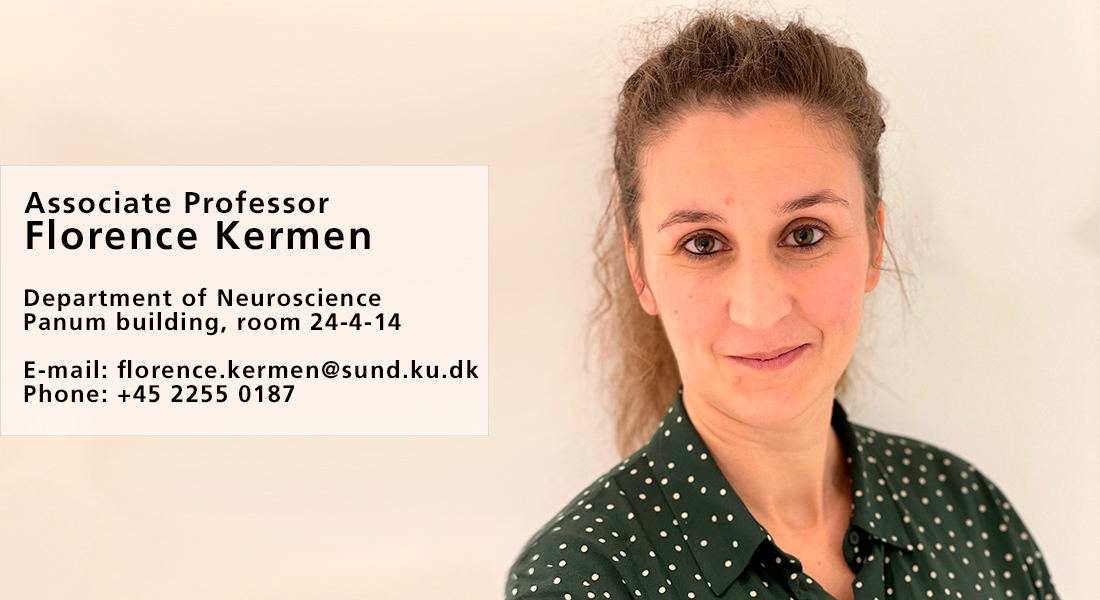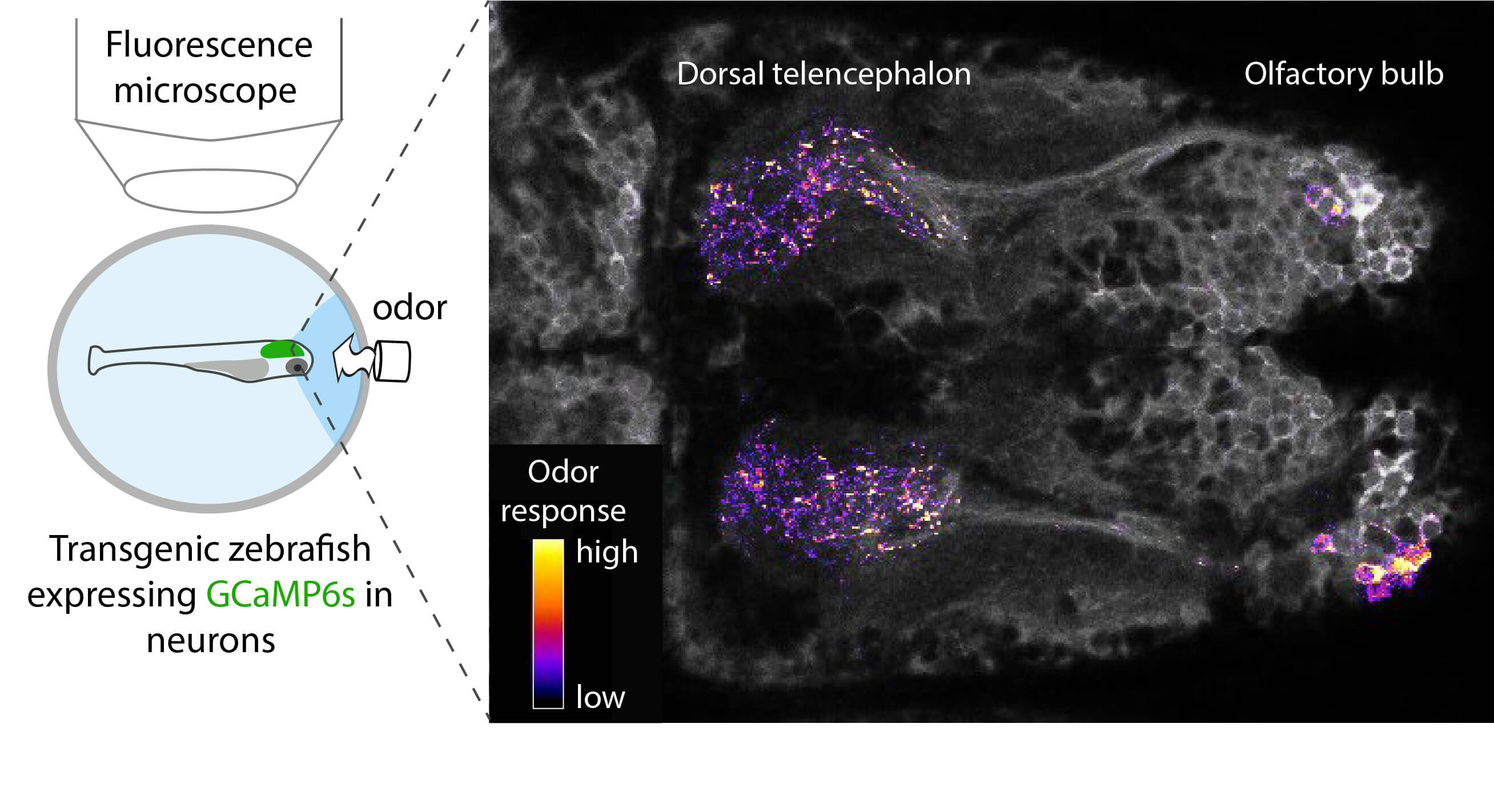Kermen Lab
Our group explores how stress affects behaviors and neuronal circuits’ activity. Our goal is to understand how stress exposure, especially during early life, can later predispose to mental health disorders such as depression and anxiety disorders.

Stress predisposes to mental disorders such as anxiety and depression, but the biological mechanisms linking neural alterations to maladaptive behaviors are ill-understood. Our group explores the function of neuronal circuits in physiological and pathological states, with a special focus on circuits implicated in sensory and defensive behaviors. We combine anatomical and functional neurophysiology methods with behavioral assays to better understand how stressor exposure influences neural activity and underlies maladaptive behaviors.
The Kermen lab utilizes the zebrafish, a small and transparent vertebrate model, which holds great potential for translational research in stress-induced mental disorders. Zebrafish share high genetic homology with human. Importantly, the essential functions of the stress neuroendocrine system, the neurotransmitters systems and affective processing circuits are conserved.
We use non-invasive fluorescence microscopy to record brain wide neural activity in vivo, which is reported by change in fluorescence of genetically encoded indicators (e.g. GCaMP6). The small size of the zebrafish brain also enables us to record and manipulate neuronal activity at later developmental stages, in ex vivo whole brain explant preparations (Kermen et al. BMC Biology 2020; Kermen et al. Plos Biology 2020).
 We use and adapt assays to measure anxiety-like and sensory-driven behaviors in larval and adult zebrafish (Golla et al. Scientific reports 2020; Kermen et al., BMC Biology 2020). Quantitative analysis of several metrics enables us to precisely characterize behavioral alterations, and how they can be reverted by pharmacological or opto- or chemogenetic manipulations of neuronal activity.
We use and adapt assays to measure anxiety-like and sensory-driven behaviors in larval and adult zebrafish (Golla et al. Scientific reports 2020; Kermen et al., BMC Biology 2020). Quantitative analysis of several metrics enables us to precisely characterize behavioral alterations, and how they can be reverted by pharmacological or opto- or chemogenetic manipulations of neuronal activity.

We are also interested in how vertebrates cope with heat-stress and developed a novel assay to characterize locomotor and neural dysfunctions occurring with increasing temperatures (Andreassen et al., PNAS 2022). By characterizing neural circuits’ function in abnormal heat, we aim to provide new knowledge on heat-induced illnesses affecting the brain (e.g. heat strokes), whose prevalence increases as extreme heat events become more frequent and intense.
Andreassen A, Hall P, Khatibzadeh P, Jutfelt F, Kermen F. (2022) Brain dysfunction during warming is linked to oxygen limitation in larval zebrafish. PNAS.
Golla A, Østby H, Kermen F. (2020) Chronic unpredictable stress induces anxiety-like behaviors in young zebrafish. Scientific Reports.
Kermen F, Darnet L, Wiest C, Palumbo F, Bechert J, Uslu O, Yaksi E. (2020) Stimulus-specific behavioral responses of zebrafish to a large range of odors exhibit individual variability. BMC Biology.
Kermen F, Lal P, Faturos NG, Yaksi E. (2020) Interhemispheric connections between olfactory bulbs improve odor detection. PLoS Biology.
Kermen F*, Midroit M*, Kuczewski N, Forest J, Sacquet J, Benetollo C, Richard M, Didier A, Mandairon N. (2016) Topographical representation of odour hedonics in the olfactory bulb. Nature Neuroscience.
Kermen F*, Franco LM*, Wyatt C, Yaksi E. (2013) Neural circuits mediating olfactory-driven behavior in fish. Frontiers in Neural Circuits.
EMPLOYEMENT and EDUCATION
| 2021 - | Associate Professor & Group Leader, Department of Neuroscience, University of Copenhagen, Copenhagen, Denmark |
| 2018 - 2021 | Adjunct Associate Professor & Group Leader, Department of Biology, Norwegian University of Science and Technology (NTNU), Trondheim, Norway |
| 2017 - 2018 | Researcher, Kavli Institute for Systems Neuroscience (KISN), NTNU, Trondheim, Norway |
| 2015 - 2016 | Post-doctoral Researcher, KISN, NTNU, Trondheim, Norway |
| 2012 - 2015 | Post-doctoral Researcher, Neuroelectronics Research Flanders, Leuven, Belgium |
| 2008 - 2012 | PhD Fellow, Lyon1 University/Center for Neuroscience Research, Lyon, France |
| 2006 - 2008 | Master’s degreein Biosciences, Ecole Normale Superieure, Lyon, France |
SCIENTIFIC GRANTS AND AWARDS
| 2023 | Kavli Foundation – Exploration Award (Project Leader) |
| 2023 | Carlsberg Foundation - Research infrastructure (Project Leader) |
| 2022 | Gerda og Aage Haenschs Fond (Project leader) |
| 2022 - 2023 | Brain & Behavior Research Foundation – Young Investigator grant (Project leader) |
| 2022 - 2025 | Lundbeckfonden - Ascending Investigator (Project leader) |
| 2019 | NTNU equipment funding (Co-applicant; Project Leader Clare Stawski) |
| 2018 - 2020 | NTNU Starter package grant (Project leader) |
| 2017 - 2021 | NTNU Outstanding Academic Fellow (Career development award) |
| 2017 - 2020 | FRIPRO - Young Research Talent grant (Project leader) |
| 2016 | ISOT - Young Investigator Award |
| 2013 - 2015 | Fyssen Foundation Post-Doctoral Fellowship |
| 2009 - 2012 | French Ministry of research Doctoral Fellowship |
| 2005 - 2009 | French Civil servant undergraduate scholarship |
- Zebrafish vertebrate model: Wild-type and transgenic lines
- Fluorescence microscopy: epifluorescence, confocal, two-photon and light-sheet microscopy
- Calcium imaging: in vivo (in larvae) and ex vivo (in brain explants) recordings in transgenic zebrafish expressing a genetically encoded calcium indicator
- Manipulation of neural activity using optogenetics; chemogenetics; electrical and pharmacological stimulations
- Behavioral assays: anxiety-like behaviors (novel tank, dark-light, and open field tests); social behaviors (shoaling); olfactory, visual and heat-evoked behaviors
- Neuronal tracing using sparsely labelled transgenic lines and dextran-coupled dye electroporation
- Immunohistochemistry
- MATLAB and Python programming for instrumentation control and data analysis
# senior corresponding author.
* equal contributions.
17. Anttonen T, Burghi T, Duvall L, Fernandez M, Gutierrez G, Kermen F, Merlin C, Michaiel A. (2023) Neurobiology and Changing Ecosystems: Mechanisms Underlying Responses to Human-Generated Environmental Impacts. Journal of Neuroscience.
16. Andreassen A, Hall P, Khatibzadeh P, Jutfelt F, Kermen F#. (2022) Brain dysfunction during warming is linked to oxygen limitation in larval zebrafish. PNAS.
15. Kermen F#, Mandairon N, Chalençon L. (2021) Odor hedonics coding in the vertebrate olfactory bulb. Cell and Tissue Research, Special Issue on "Olfactory Coding and Circuitries". Cell and Tissue Research.
14. Golla A, Østby H, Kermen F#. (2020) Chronic unpredictable stress induces anxiety-like behaviors in young zebrafish. Scientific Reports.
13. Kermen F, Darnet L, Wiest C, Palumbo F, Bechert J, Uslu O, Yaksi E. (2020) Stimulus-specific behavioral responses of zebrafish to a large range of odors exhibit individual variability. BMC Biology.
12. Kermen F, Lal P, Faturos NG, Yaksi E. (2020) Interhemispheric connections between olfactory bulbs improve odor detection. PLoS Biology.
11. Mandairon N, Kuscewsky N, Kermen F, Forest J, Midroit M, Richard M, Thevenet M, Sacquet J, Linster C, Didier A. (2018) Opposite regulation of inhibition by adult-born granule cells during implicit versus explicit olfactory learning. Elife.
10. Kermen F*, Midroit M*, Kuczewski N, Forest J, Sacquet J, Benetollo C, Richard M, Didier A, Mandairon N. (2016) Topographical representation of odour hedonics in the olfactory bulb. Nature Neuroscience.
9. Vinera J, Kermen F, Sacquet J, Didier A, Mandairon N, Richard M. (2015) Olfactory perceptual learning requires action of noradrenaline in the olfactory bulb: comparison with olfactory associative learning. Learning & Memory.
8. Mandairon N, Kermen F*, Charpentier C*, Sacquet J, Linster C and Didier A. (2014) Context- driven activation of odor representations in the absence of olfactory stimuli in the olfactory bulb and piriform cortex. Frontiers in Behavioral Neuroscience.
7. Kermen F*, Franco LM*, Wyatt C, Yaksi E. (2013) Neural circuits mediating olfactory-driven behavior in fish. Frontiers in Neural Circuits.
6. Kermen F*, and Chakirian A*, Sezille C, Joussain P, Le Goff G, Ziessel A, Chastrette M, Mandairon N, Didier A, Rouby C & Bensafi M. (2011) Molecular complexity determinesthe number of olfactory notes and the pleasantness of smells. Scientific reports.
5. Joussain P, Chakirian A, Kermen F, Rouby C, and Bensafi M. (2011) Physicochemical influence on odor hedonics: Where does it occur first? Communicative & integrative biology.
4. Kermen F, Sultan S, Sacquet J, Mandairon N, and Didier A. (2010) Consolidation of an olfactory memory trace in the olfactory bulb is required for learning-induced survival of adult-born neurons and long-term memory. PLoS One.
3. Sultan S, Mandairon N, Kermen F, Garcia S, Sacquet J, and Didier A. (2010) Learning-dependent neurogenesis in the olfactory bulb determines long-term olfactory memory. The FASEB Journal.
2. Mandairon N, Sultan S, Rey N, Kermen F, Moreno M, Busto G, Farget V, Messaoudi B, Thevenet M, Didier A. (2009) A computer-assisted odorized hole-board for testing olfactory perception in mice. Journal of neuroscience methods.
1. Busto G, Elie J, Kermen F, Garcia S, Sacquet J, Jourdan F, Marcel D, Mandairon N, Didier A. (2009) Expression of Zif268 in the granule cell layer of the adult mouse olfactory bulb is modulated by experience. European Journal of Neuroscience.
Development of automated analysis pipeline for behavioral and/or neuronal data
We have several BSc or MSc thesis projects for students interested in applying their expertise in programming to neuroscience data.
In our research group at the Department of Neuroscience, we study how stress affects behaviors and neuronal circuits’ activity. Our goal is to understand how stress exposure, especially during early life, can later predispose to mental health disorders such as depression and anxiety disorders. To do so, we record the behavior and brain activity of small and transparent zebrafish under different states of relaxation or stress. This typically gives rise to terabytes of images, from which specific behavioral or neuronal activity patterns should be automatically extracted and compared.
The projects involve writing, or adapting already published, software to analyze behavioral and neural activity data already collected in our lab. For example, you would make use of methods such as automated segmentation, motion correction, registration, detection of behavioral patterns, graph theory applied to neuronal ensembles, etc.
We offer close supervision and integration in a dynamic, young and international research team of neuroscientists at UCPH in the center of Copenhagen.
Required: interest for neuroscience; advanced programming in MATLAB and/or Python; basic knowledge of image analysis.
Application: Contact Florence Kermen (Florence.kermen@sund.ku.dk) including a CV/description of your academic background and a grade transcript.
Open positions
We also encourage students, interested in joining the group for their Bachelor or Master’s thesis, to enquire about prospective projects (incl. behavioral & physiological measurements in zebrafish; fluorescence microscopy; neuroanatomical and molecular biology techniques; functional neural data analysis).
We welcome diverse relevant educational backgrounds, - e.g. physics, computational data science, mathematics, medicine, neuroscience, biochemistry, veterinary sciences - provided a keen interest in neurophysiological lab work.
If you would like to join us, please contact Assoc. Prof. Florence Kermen (florence.kermen@sund.ku.dk).
Lab members
| Name | Title | Job responsibilities | Image |
|---|---|---|---|
| Search in Name | Search in Title | Search in Job responsibilities | |
| Alessio Cao | Master-Student | Kermen Lab |
|
| Florence Kermen | Associate Professor | Kermen lab |
|
| Haritha Polagari | Postdoc | Kermen Lab |
|
| Ilayda Birben Fahliogullari | Guest Researcher | Kermen Lab |
|
| João Henrique Campagnolo | PhD Fellow | Kermen Lab |
|
| Laia Pagès Rigola | Erasmus Master Student | Kermen Lab |
|
| Lucía Jiménez Fernández | PhD Fellow | Kermen Lab |
|
| Morten Bjerre | Laboratory Technician | Rekling Lab, Kermen Lab |
|
| Zoltán Kristóf Varga | Postdoc | Kermen Lab |
|
